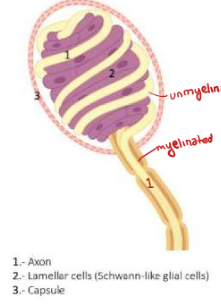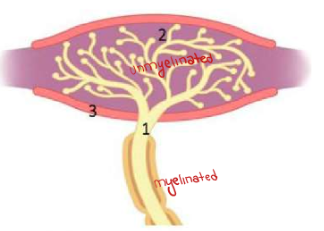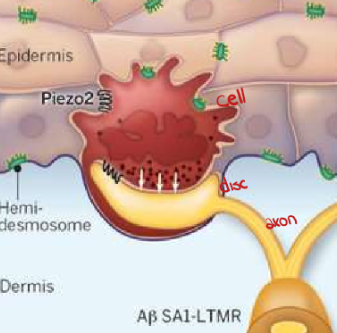Mechanoreceptors
1/26
There's no tags or description
Looks like no tags are added yet.
Name | Mastery | Learn | Test | Matching | Spaced |
|---|
No study sessions yet.
27 Terms
Thalamic Nuclei for Mechanoreceptor information
Ventral posterolateral nuclei
Slow adapting
tonic - fire continuously, for constantly present stimuli
Fast adapting
phasic - fire rapidly initially, for changes in stimulu
Glabrous skin
hairless skin, palms of hands and bottom of feet
Hairy skin
majority of skin
mechanoreceptors in glabrous skin
mainly meissner’s corpuscles
mechanoreceptors in hairy skin
fewer touch receptors
Meissner’s Corpuscles Location
Below epidermis of glabrous skin, in the dermal papillae of papillary dermis
Meissner’s Corpuscles Detection
discriminative fine touch and low-frequency vibrations
Meissner’s Corpuscles Structure
like sperm - unmyelinated axons surround stacks of lamellar cells, endoneurial capsule surrounds, and axon becomes myelinated

Meissner’s Corpuscles Speed
Fast adapting type I
Mechanoreceptor transduction
physical deformation acts as stimulus, generates AP, into dorsal root then dorsal column and up to S1
Ruffini Endings Location
dermis of glabrous and hairy skin, parallel to stretch lines
Ruffini Endings Structure
unmyelinated tree branches of an axon embedded in glial cells, surrounded by endoneurial capsule

Ruffini Endings Speed
Slow Adapting Type II
Ruffini Endings Detection
stretching of skin, small proprioceptive angle changes, continuous pressure, thermoreceptor (heat)
Pacinian Corpuscles Location
deep dermis and hypodermis of glabrous and hairy skin, viscera and joints
Pacinian Corpuscles Detection
vibration(high) and pressure of grasp and release
Pacinian Corpuscles Structure
Neural compartment with unmyelinated axon and lamellar cells, intermediate layer of fibrous capsule, non-neural component containing and outer core and capsule

Pacinian Corpuscles Structural Distinction
uniform distribution
Pacinian Corpuscles Speed
Fast Adapting Type II
Merkel’s Cells Location
In epidermis but along dermal ridges of glabrous and hairy skin
Merkel’s Cells Structure
cell embedded in dermis with a disk below it, completely myelinated

Merkel’s Cells Speed
Slow Adapting Type I
Merkel’s Cells Detection
light pressure, proprioception, deep static/continuous touch
Merkel’s Cells Transduction
deformation of cell, release NT received by disk to create AP
Minor Mechanoreceptors
Hair and Nerve fibers, free nerve endings